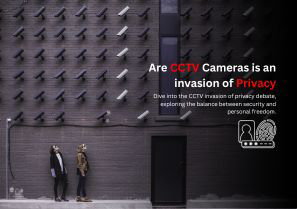CCTV security systems have been used for decades as an important tool for maintaining safety and security. However, as artificial intelligence (AI) technology has evolved, CCTVs with AI Integration have grown much more advanced and effective.
In this article, we will look at the positive aspects of AI integration with CCTV security, compare it to traditional CCTV systems, and discuss some of the challenges and concerns that come with AI-integrated CCTV systems.

What is AI integration with CCTV security?
AI integration with CCTV security involves the use of machine learning algorithms to enhance the capabilities of traditional CCTV systems. AI algorithms can detect and track objects, recognize faces, and analyze human behavior in real-time, allowing for the identification of potential security threats. Let’s look at it in detail.
A comparison of why CCTV with AI Integration can be a better option?
The integration of AI technology has significantly improved the effectiveness of CCTV systems. Here are some key differences between CCTV with and without AI integration:
Object Detection and Tracking:
CCTV systems without AI integration rely on human operators to monitor footage and identify potential threats. This can be a slow and inefficient process and may result in missed or delayed responses to security threats.
With AI integration, CCTV cameras can detect and track objects within their field of view, allowing for the identification of suspicious behavior or unusual activity in real time.
Facial Recognition:
Traditional CCTV systems may capture footage of potential suspects, but without AI integration, there is no efficient way to identify them.
AI-enabled CCTV cameras can recognize faces and match them against a database of known individuals, making it easier to identify potential suspects or persons of interest.

Anomaly Detection:
Traditional CCTV systems may capture unusual behavior, but it may not be immediately apparent to human operators.
AI algorithms can detect anomalies in video footage, such as unusual patterns of movement or unexpected changes in lighting conditions, and alert security personnel to potential security threats
Behavioral Analysis:
Traditional CCTV systems can capture footage of suspicious behavior, but without AI integration, it can be difficult to analyze and detect.
AI can analyze human behavior in real-time, allowing for the detection of suspicious activity such as loitering, aggressive behavior, or unattended baggage.
Predictive Analytics:
Traditional CCTV systems only provide footage of past events while CCTV cameras with AI integration can use machine learning algorithms to analyze historical data and predict future security threats.
This provides security personnel with valuable information that they can use to proactively prevent security threats.
It’s overall a better choice to integrate AI in security systems rather than using it without AI. Apart from these factors here are some other benefits of AI integration:
Some other benefits of CCTV with AI Integration.
- AI-enabled CCTV cameras can analyze video footage in real-time, allowing for immediate response to security threats.
- AI algorithms can detect and classify security events, providing alerts to security personnel when needed, and reducing the likelihood of false alarms.
- With AI integration, CCTV cameras can monitor multiple areas simultaneously, providing comprehensive situational awareness of a premises.
- AI algorithms can detect and track objects with greater accuracy than traditional video analytics, reducing false positives and increasing the efficiency of security personnel.
- CCTV cameras with AI integration can reduce the need for human security personnel, lowering labor costs and increasing efficiency.
- CCTV cameras with AI can use machine learning to analyze data from multiple sources, allowing for the prediction of potential security threats before they occur.
- AI-enabled CCTV cameras can analyze data from multiple sources, such as traffic patterns, weather conditions, and social media, providing valuable insights for enhancing security.
By far looking at these factors and benefits we can safely say that, if anyone wants a more advanced security game, CCTV with AI integration is the way to go. It’s fast, accurate, and has a ton of useful features that can help keep people safe.
However, it is equally important to consider some of the potential risks that come along with it. Let’s have a look at them.

Challenges of AI-Enabled CCTV:
While CCTV with AI integration has a lot of benefits, there are also some challenges to consider. Here is a list of potential challenges and limitations of integrating AI with CCTV Security systems:
Privacy concerns:
One of the main challenges is privacy concerns. The use of facial recognition and other biometric technologies can raise concerns about privacy and the collection and use of personal data.
False positives:
Another challenge is false positives. While AI algorithms can detect potential security threats, they may also produce false positives, leading to unnecessary alerts and interventions. This can waste time and resources, and even cause public concern or panic.
Technical limitations:
Technical limitations are also a challenge with AI-enabled CCTV cameras. These cameras may have limitations in terms of processing power, bandwidth, and storage capacity, which can affect their effectiveness in detecting and analyzing security events.
They may also be more expensive to maintain and update compared to traditional CCTV systems.
Security risks:
Another challenge is security risks. AI-enabled CCTV cameras can be vulnerable to cyber-attacks, which can compromise their functionality and potentially put sensitive data at risk. This is a major concern, especially as the use of AI in security continues to grow.
Ethical considerations:
Ethical considerations are also important to consider. The use of AI in security raises ethical considerations around the use of force, discrimination, and accountability. These issues can be complex and require careful consideration and planning.
Training data bias:
Training data bias is another challenge with AI algorithms. These algorithms rely on training data, which can be biased or incomplete, leading to inaccurate or unfair decisions.
This can have serious consequences for individuals and communities and requires ongoing monitoring and evaluation.
Integration challenges:
Finally, integration challenges can arise when integrating AI-enabled CCTV cameras with existing security systems and processes. This can be complex, requiring expertise in both security and AI, and can lead to compatibility issues and delays in implementation.
As we can see while AI-enabled CCTV has many benefits, it’s important to carefully consider these challenges and work to address them in order to ensure effective and ethical implementation of this technology.

Conclusion:
Overall, AI integration in CCTV security has the potential to revolutionize the way we think about safety and security. However, it is crucial to address the challenges and concerns associated with the technology to ensure its ethical and effective use.
By working together to overcome these challenges, we can create a safer and more secure environment for everyone.
This blog is written by Neha Iram. Neha is a professional writer based out of New Delhi, India. If you want to check her work related to AI and marketing you can check her website quirkywriteups.com






